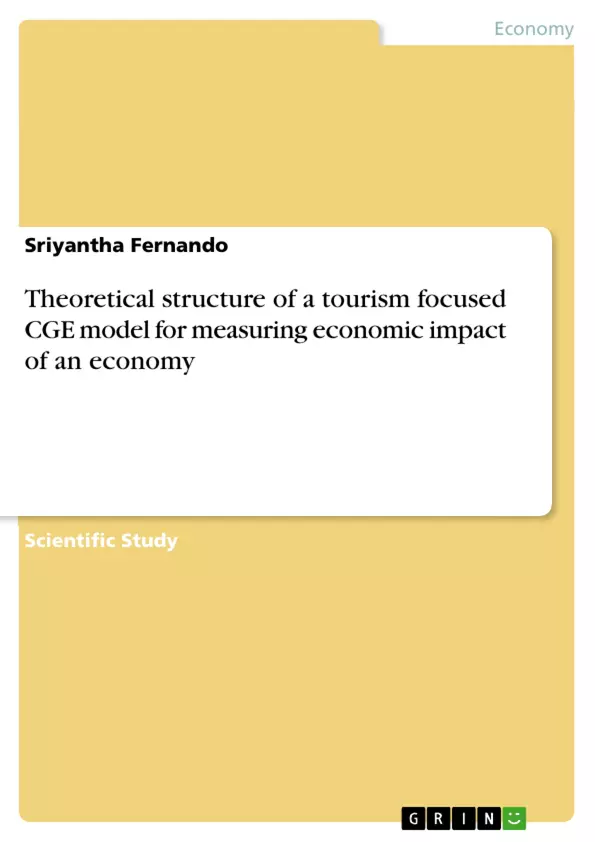Measuring the contribution of tourism to a national economy has always been a frustrating exercise. Tourism does not have specific products. It represents the sum of expenditure by travellers for wide range of products. It is not possible to identify tourism as a single "industry" in the national accounts, its value to the economy is not readily revealed.
As a result of the absence of tourism in official economic statistics, there is often an on-going battle to establish tourism credibility as an economic activity and generator of income in the economy. As a result, a significant volume of tourism research over the past few decades have focussed on the development and use of a variety of economic techniques aimed at quantifying the effects of tourism on an economy. In conventional literature has proven that Computable General Equilibrium (CGE) modelling is the best applied tool addressing and analysing tourism related issues in an economy.
The paper provided a complete description of the theoretical structure of the CGE-Tourism including all equations and variables by using relevant Excerpts for different blocks of equations in the TABLO file associated with the GEMPACK software used to operationalise the model. The incorporation of tourism using the dummy sector approach into an ORANI type CGE model as an extension and can be considered as the main contribution of this study to the CGE modelling literature for An economy. This is a clear departure from the traditional methods used for tourism modelling in an economy. This model can be used to simulate the economic impact of the tourism boom in an economy.
Inhaltsverzeichnis (Table of Contents)
- Introduction
- Economic Impact Analysis of Tourism
- An Overview of the Model
- The Theoretical Structure of the Model
- Implementing the Model
- Dimensions of the Model
- Variables and Coefficients of the Model
- The System of Equations of the Model
- Input Demands for Current Production
- Demand for Different Occupational Categories of Labour
- Demands for Aggregated labour, Capital and Land
- Demands for Intermediate Inputs
- Top Level Demands for Composite Inputs
- Supply of Outputs for Domestic Market and Export Market
- Inputs Demands for the Production of Fixed Capital
- Demand Equations
- Household Demands
- Foreign Demand for Exports
- Government Demands
- Inventory Demands
- Demands for Margins
- Price System and Zero Profit Conditions
- Power of Taxes and Indirect Tax
- Market Clearing Equations
- Miscellaneous Equations
- Gross Domestic Product (GDP)
- Trade Balance, Basic Imports and Real Exchange Rate
- Primary Factor Aggregates
- Investment and Rates of Return
- Labour Market Equilibrium
- Input Demands for Current Production
- Modelling the Tourism Sector
- Modification of Data Structure
- Theoretical Structure of the Tourism Extension
- Concluding Remarks
Zielsetzung und Themenschwerpunkte (Objectives and Key Themes)
This paper aims to develop a Computable General Equilibrium Model for an economy, specifically designed for tourism impact analysis. The model, known as CGE-Tourism, draws heavily from the Australian ORANI model, incorporating recent advancements in tourism modelling. It aims to provide a comprehensive framework for analyzing the economic impact of tourism on a national level.
- Measuring the economic impact of tourism
- Developing a CGE-Tourism model for impact analysis
- Implementing the model and analyzing its results
- Exploring the role of tourism in the economy
- Understanding the theoretical structure of the model
Zusammenfassung der Kapitel (Chapter Summaries)
- Introduction: This chapter discusses the challenge of measuring tourism's contribution to a national economy. Tourism is not readily identifiable as a distinct industry in national accounts, making it difficult to quantify its economic impact. The chapter highlights the need for economic techniques to address this issue.
- Economic Impact Analysis of Tourism: This chapter provides a brief summary of economic impact analysis of tourism, highlighting its importance in understanding the contribution of tourism to an economy.
- An Overview of the Model: This chapter outlines the structure and implementation of the CGE-Tourism model. It explains the theoretical framework, dimensions, variables, and coefficients used in the model.
- The System of Equations of the Model: This chapter details the system of equations that form the core of the CGE-Tourism model. It covers various aspects of the model, including input demands, supply of outputs, demand equations, price system, and market clearing equations.
- Modelling the Tourism Sector: This chapter focuses on the extension of the core model to incorporate tourism. It explains the modification of the data structure and the theoretical structure of the tourism extension.
Schlüsselwörter (Keywords)
This paper focuses on the economic impact of tourism, employing Computable General Equilibrium (CGE) modelling as a primary tool for analysis. It utilizes the ORANI model as a foundation and incorporates recent advancements in tourism-focused CGE modelling. The work explores the theoretical structure of the CGE-Tourism model, highlighting key variables, equations, and extensions to capture the impact of tourism on an economy.
- Quote paper
- Dr. Sriyantha Fernando (Author), 2017, Theoretical structure of a tourism focused CGE model for measuring economic impact of an economy, Munich, GRIN Verlag, https://www.grin.com/document/370462



